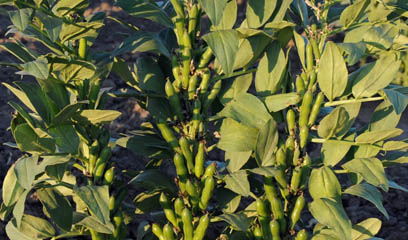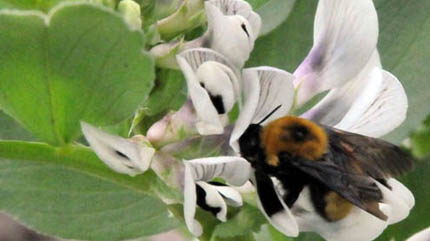Soil Science Society of America
5585 Guilford Road • Madison, WI 53711-5801 • 608-273-8080 • Fax 608-273-2021
www.soils.org
Twitter | Facebook
NEWS RELEASE
Contact: Hanna Jeske, Associate Director of Marketing and Brand Strategy, 608-268-3972, hjeske@sciencesocieties.org
Cool beans: beneficial faba braves a freeze
Apr. 6, 2016 - What bean has double the protein of wheat, triple that of rice, and also contains beneficial amino acids, B-vitamins, and micronutrients? The unassuming faba bean, of course.
 Faba beans have many unique properties. In terms of human consumption, they are high in protein and other important nutrients. They can also greatly benefit the soil. Faba beans, like other members of the pulse family, pull valuable nitrogen from the air so it becomes usable by the faba bean and other plants. The faba bean has one of the highest capacities for performing this service.
Faba beans have many unique properties. In terms of human consumption, they are high in protein and other important nutrients. They can also greatly benefit the soil. Faba beans, like other members of the pulse family, pull valuable nitrogen from the air so it becomes usable by the faba bean and other plants. The faba bean has one of the highest capacities for performing this service.
Additionally, they are valued as a cover crop. Instead of leaving the soil bare — and susceptible to water and wind erosion — farmers can plant faba beans. The beans’ roots, stems, and leaves add mulch and protect the soil.
Most cover crops are planted in the fall to protect fields through the winter. However, the typical faba bean does not do well in cold weather.
“In areas like the Palouse in Washington State, it’s required for these cover crops to be winter-hardy,” explains Jinguo Hu. Hu is a research leader with the USDA Agricultural Research Service. “They are usually planted in the spring. But if you are able to plant a winter-hardy variety in the fall that will survive the winter, they’ll better protect the soil from erosion.”
 To solve this problem, Hu and a team of researchers at Washington State University worked to find winter-hardy faba germplasm lines — batches of seed with genetic traits that help them survive in colder conditions. Researchers started with 175 seed samples from across the world. After six years of planting selected generations of seed, four survivors came out as winter-hardy to USDA plant hardiness zone 6b.
To solve this problem, Hu and a team of researchers at Washington State University worked to find winter-hardy faba germplasm lines — batches of seed with genetic traits that help them survive in colder conditions. Researchers started with 175 seed samples from across the world. After six years of planting selected generations of seed, four survivors came out as winter-hardy to USDA plant hardiness zone 6b.
Hu explains that the plants became more winter hardy by a process called selection. “Diversity is the base of selection. We planted many different varieties together and allowed the natural gene flow to maximize the gene combinations for selection,” Hu says. “We didn’t isolate the different plants. Pollinators like bumble bees simply cross-pollinated the plants and helped these new lines develop.”
This method can increase how many beneficial traits plants have to help them survive the winter. For example, if a bee pollinates a plant with one beneficial gene with pollen from a different plant with another beneficial gene, this will result in an offspring seed with both beneficial genes.
 The new faba bean types serve as a resource for researchers and breeders who are looking for other properties. Hu also adds that as climate continues to change, these types of experiments are also useful for finding plants with heat or drought tolerance.
The new faba bean types serve as a resource for researchers and breeders who are looking for other properties. Hu also adds that as climate continues to change, these types of experiments are also useful for finding plants with heat or drought tolerance.
“The next step is to get growers and companies interested in our work,” he says. “I’ve starting working with some in Washington and even in California. Experimental seed samples have been sent to requesters from Pennsylvania, Wisconsin, North Carolina, New Mexico, Oregon, Montana, Missouri, Nebraska, and Virginia for grow-out observation trials. The faba bean definitely has a place in the national market.”
Details of Hu’s work are published in Journal of Plant Registrations.
Faba and other dried beans are part of a food group known as pulses. The United Nations Food and Agriculture Organization declared 2016 the International Year of Pulses (IYP). In celebration, the Crop Science Society of America (CSSA) created a web page for the public about pulses, https://www.crops.org/iyp. Special tabs for the public include K-12 Education, Beans in the News, Grown Your Own, and Delicious Ideas. CSSA has also compiled links to various recipes, so you can increase your consumption of pulses.
CSSA will release more information about pulses during the 2016 IYP celebration.
Journal of Plant Registrations is the official registration publication of the Crop Science Society of America. JPR publishes cultivar, germplasm, parental line, genetic stock, and mapping population registrations, as well as articles characterizing accessions held within plant germplasm collection systems and descriptions of plant genetic materials.